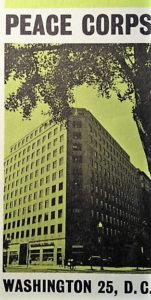“An Example for Government” (Part Two)
 It was apparent from the beginning that we would need talented people in the Maiatico Building, (the first Peace Corps HQ, across from Lafayette Square and the White House) who had wide experience in government work. The question was—how would we find them? We followed the principle that one good man would bring another. So Warren Wiggins got us Jack Young from NASA, a demon of energy and creativity who organized our management services.
It was apparent from the beginning that we would need talented people in the Maiatico Building, (the first Peace Corps HQ, across from Lafayette Square and the White House) who had wide experience in government work. The question was—how would we find them? We followed the principle that one good man would bring another. So Warren Wiggins got us Jack Young from NASA, a demon of energy and creativity who organized our management services.
Jack Young got us Bill Kelly, who was the man at NASA in charge of efficiently moving such things as Saturn boosters from Huntsville, Alabama to Cape Canaveral. We decided he would be just the man to solve the problems of how best to transport Peace Corps Volunteers from the United States to the ends of the earth. Bill came to us on 3 days’ notice and he has performed one of the most outstanding jobs in contracting and logistics ever seen in Washington. Through his tough minded negotiations, he saved the nation’s taxpayers millions.
We went to Dr. Arthur Adams, president of the American Council on Education and a member of the council’s ad hoc committee on the Peace Corps, and told him we needed a top-flight man to run training. Dr. Adams brought in resumes of seven different candidates, all well qualified, but the ad hoc committee was in unanimous agreement that Larry Dennis was the best choice.
We sent Larry a telegram not really knowing how he felt about the Peace Corps. As it turned out, he received the telegram in Chicago, where he had gone to address the American Council on Higher Education—in support of the Peace Corps. Larry came to work the following week.
Everyone agreed that the process of selecting Volunteers would be a critical problem—perhaps the most crucial of all. But our big question was who would be the best man to head up a selection division.
We asked Dr. John Darley, executive director of the American Psychological Association, to give us some recommendations. Dr. Darley brought in a selection of seven resumes. Six of these he described as “men who hit in the eighties.” The one man who “played in the low seventies,” according to Dr. Darley, was Nick Hobbs. We asked Dr. Darley to call Nick and sound him out.
“How much time do I have to decide?” Nick asked. “Twenty minutes,” Dr. Darley replied. Twenty minutes later, Nick was working for the Peace Corps.
The success of the system he established is demonstrated by the scant number of “failures” who could be counted out of the first 1,000 Peace Corps Volunteers sent abroad.
In those hectic, early days of organization we often were forced to make some drastic demands on people.
At this point in Peace Corps history, our payroll arrangements were woefully slow and inadequate—most of these people worked for as long as three months without pay.
But they came to the Peace Corps anyway.
Ed Bayley in Wisconsin got a telegram from us late at night asking for his help. He arrived in Washington the next day—and never went back.
Tom Matthews was away from home, on a skiing trip to Alta, Utah, when a telegram reached him there. He arrived in Washington still wearing his ski boots. He became Bayley’s deputy.
Gordon Boyce, now president of the Experiment in International Living, got a telegram too. He arrived the very next afternoon, took an immediate leave of absence from his job, and stayed for seven months as director of the Division of Private Organizations.
When Lee St. Lawrence paid his first visit to the Peace Corps office, he took one long look at the surrounding confusion, offered the unsolicited opinion that “this place is all fouled up,” then wanted to know which desk he should use.
Our “talent search” turned up Frank Williams and Dick Graham. Lloyd Wright was highly recommended by Bill Moyers. Jules Pagano came to us recommended by Joseph Bierne, president of the Communications Works of America.
I met Jack Vaughn during a tour of Africa and was impressed by him. He was an experienced Latin American expert not too happy in his African assignment, and when we needed a man to head up our South American program, I immediately thought of him.
To my way of thinking, one of the best tests of the soundness and validity of the “Peace Corps” was the high quality of the people who immediately came forward and expressed a desire to be a part of it—to organize it, to serve it, and to serve in it.
Sargent Shriver, Director
No comments yet.
Add your comment